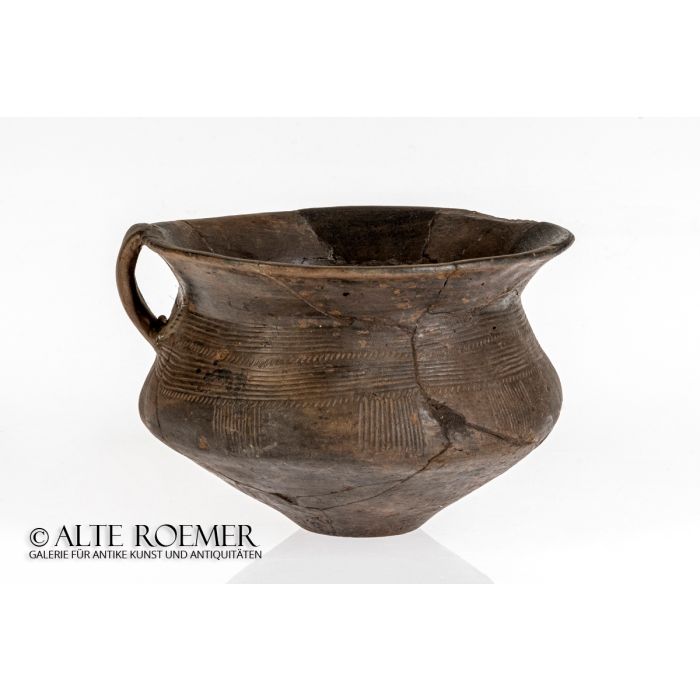Beaker of the Urnfield culture
€600
Sold
Object number
AR2697
| Object: |
Beaker of the Urnfield culture
|
| Material: |
Clay with black slip.
|
| Period: |
Urnfield period, C. 1200 BC to 800 BC. Late Bronze Age to Early Iron Age in Central Europe. |
| Description: |
Beaker with flat bottom, angled body, neck directed straight outwards. A strap handle goes from the lip to the middle of the shoulder. Nice banded decor on the shoulder.
|
| Background: |
The end of the second millenium before our era was a time of upheaval in Central Europe. The changes in culture and politics can also be seen in the archaeological evidence.
For example in the wide spread use cremation burials. But also in the grave goods coming with that new tradition. The ashes of the deceased were placed in pottery vessels and covered with a pottery bowl or a flat stone. One big urn was accompanied by four to six smaller vessels. The metal objects for burial were mostly made of Bronze, but now also the first objects made of iron appear in Central European graves. This indicates that the Urnfield period was a transitional phase between Bronze Age and Iron Age. Thanks to the Urnfield culture burials many objects from that exciting period have been preserved until today. |
| Dimensions: |
84mm height, 119mm diameter.
|
| Condition: |
Professionally restored from many fragments, up to 10% material added. Small chips were left unchanged during the restoration. Fantastic preservation for pottery from this period.
|
| Provenance: |
Acquired by us in 2019 from the German Rehorik family collection. The collection was built in the 1960ies and 1970ies by Hugo Rehorik. It consists entirely of archeological finds from the region around Regensburg in Germany. This artefact has been found in ... in Southern Germany. Hugo Rehorik (1905-1979) was working in the Regensburg area as an voluntary archeologist, mostly together with Hans-Jürgen Werner (1941-1997) and with the help of Gerhard and Robert Pleyer. The team supported the Landesamt für Denkmalschutz (state department of cultural heritage preservation) with the recovery of artefacts. This support was of great importance because the 1960ies saw the advent of deep plowing in Germany. Artefacts in the ground needed to be saved from destruction by the new agricultural machines quickly. The state archeologists praised this cooperation highly. It is a nice example of volunteers and professionals working together to preserve our cultural heritage. And also a role model urgently needed for today's situation in archeology. The finds were documented and examined according to scientific standards. Intricate restorations were performed by Heinz Rademacher (1929-1992) who worked for the städtische Museum Regensburg (city museum of Regensburg). Most pieces were then given to museums, namely the Historische Museum in Regensburg (Regensburg historical museum), the Naturkundemuseum Regensburg (Regensburg natural history museum) and the archäologische Staatssammlung in München (archeological state collection of Munich). Individual pieces have been split among the volunteers with the consent of the state archeologists. This way the Rehorik collection came into existence. |
| References: |
Similar Detert Zylmann, Veröffentlichungen der pflälzischen Gesellschaft zur Förderung der Wissenschaften in Speyer, Band 72, Die Urnenfelderkultur in der Pfalz, Grab. und Depotfunde, Einzelfunde aus Metall (1983), plate C, no. XV and plate D, no. XXX6. For a very similar decoration see vessel no. 9 on plate 2.
|
| Literature on the Rehorik collection: |
S. Kuchlmayr, Vom Tertiär zur Römerzeit: Hugo Rehorik u. seine Funde, in Regensburger illustriertes Stadtmagazin no. 3 / 5 (1979), pages 14f. A. Stroh, Bericht der vorgeschichtlichen Abteilung des Museums Regensburg (1965), mentions Hugo Rehorik's relation to numerous finds and research results; Stroh is praising Rehorik's contributions as an amateur archaeologist. F. D. Davis, Neue bandkeramische Gräber von Mangolding (1968), the book deals among other topics with an excavation in which Hugo Rehorik took part in. H. T. Fischer, Archäologische Ausgrabungen und Funde in der Oberpfalz (1982) mentions Hugo Rehorik and explains how thankful the local archaeologist are for their volunteers. T. Fischer, Im memoriam Hans-Jürgen Werner, in Acta Albertina Ratisbonesia 50/2, pages 231ff (1997), the memorandum includes a very good summary of the cooperation with Hugo Rehorik and the situation and working methods in the 1960ies and 1970ies. |
| Authenticity: |
We unconditionally guarantee the authenticity of every artefact, all items are subject to our lifetime return policy on authenticity.
|


